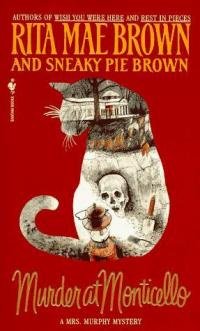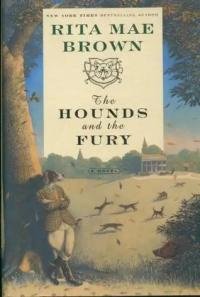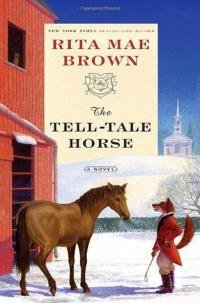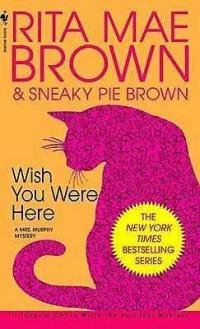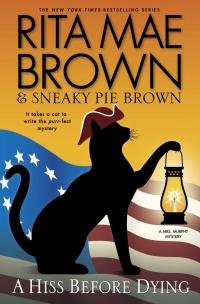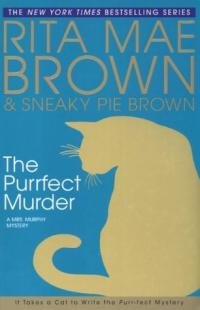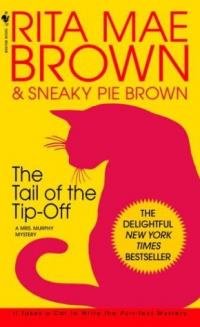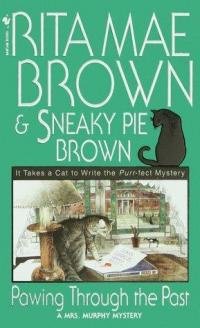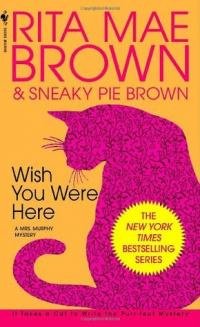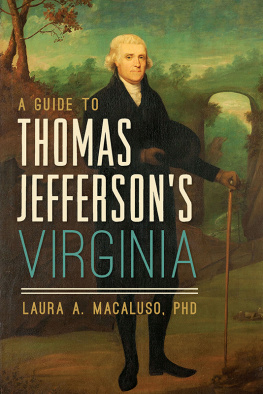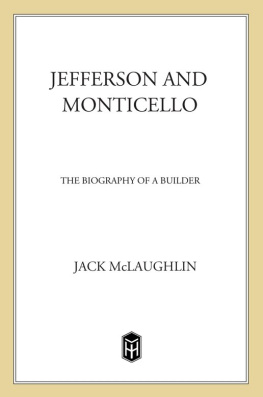MURDER AT
MONTICELLO
Rita Mae Brown
ForGordon Reistrup
because he makes us laugh.

BANTAM BOOKS NEWYORK TORONTO LONDON SYDNEY AUCKLAND
Cast of Characters
Mary Minor Haristeen (Harry), the young postmistress of Crozet, whose curiosityalmost kills the cat and herself
Mrs. Murphy, Harrys gray tiger cat, who bears an uncannyresemblance to authoress Sneaky Pie and who is wonderfully intelligent!
Tee Tucker, Harrys Welsh corgi, Mrs. Murphys friendand confidant; a buoyant soul
Pharamond Haristeen(Fair), veterinarian,formerly married to Harry
Mrs. GeorgeHogendobber (Miranda), a widow who thumpsher own Bible!
Market Shiflett, owner of Shifletts Market, next to the postoffice
Pewter, Markets fat gray cat, who, when need be, canbe pulled away from the food bowl
Susan Tucker, Harrys best friend, who doesnt takelife too seriously until her neighbors get murdered
Big Marilyn Sanburne(Mim), queen of Crozet
Oliver Zeve, the exuberant director of Monticello, to whomreputation means a lot
Kimball Haynes, energetic young head of archaeology at Monticello. Heis a workaholic who believes in digging deeper
Wesley Randolph, owner of Eagles Rest, a passionateThoroughbred man
Warren Randolph, Wesleys son. Hes trying to step intothe old mans shoes
Ansley Randolph, Warrens pretty wife, who is smarter thanpeople think
Samson Coles, a well-born realtor who has his eyes on more thanproperty
Lucinda Payne Coles, Samsons bored wife
Heike Holtz, one of the assistant archaeologists at Monticello
Rick Shaw, Albemarle sheriff
Cynthia Cooper, police officer
Paddy, Mrs. Murphys ex-husband, a saucy tom
Simon, an opossum with a low opinion of humanity
Authors Note
Monticello is a national treasure well served by itscurrent executive director, Daniel P. Jordan. Some of you will recall Mr.Jordan and his wife, Lou, opening Thomas Jeffersons home tothenPresident-elect Clinton.
The architectural andlandscape descriptions are as accurate as I could make them. The humans aremade up, of course, and Oliver Zeve, Monticellos director in this novel,is not based on Mr. Jordan.
One eerie event took placewhile I was writing this mystery. In the book, a potsherd of good china isunearthed in a slave cabin. On October 18, 1992, four days after I sent off thefirst draft of this book to my publisher, an article appeared in The DailyProgress, the newspaper of Charlottesville, Virginia. This articledescribed how William Kelso, Monticellos director of archaeology, foundsome fine china in the slave quarters believed to have been inhabited by SallyHemings. These quarters were close to Jeffersons home. Often slavequarters were distant from the masters house, so the location of MissHemings cabin is in itself worthy of note. Finding the china bits waslife imitating fiction. Who knows, but it fluffed my fur.
My only quibble with Mr.Jordan and the wonderful staff at Monticello is that they arent payingattention to the feline contributions to Mr. Jeffersons life. Who do youthink kept the mice from eating all the parchment that Mr. Jefferson used? Thenagain, my ancestors drove the moles from the garden and the rodents from thestables too. No doubt when the great man wrote the Declaration of Independencehe was inspired by a cat. Who is more independent than a cat?
Human Americans are having afit and falling in it over multiculturalism. Well, how about multispecies-ism?You think the world centers around humans? When history is taught, Americansreally ought to give full attention to the contributions of cats, dogs, horses,cattle, sheep, henswhy, just about any kind of domesticated animal andsome of the wild too. Where would our Founding Fathers and Mothers be if theyhadnt had wild turkeys to eat? So abandon that human-centric point ofview.
For my part, my felineancestors arrived on Tidewater shores in 1640. The first Americat was a tabby,one Tabitha Buckingham. I am, therefore, F.F.V.First Felines ofVirginia. Of course, I take pride in my heritage, but I believe any kitty whocomes to this country is as much an Americat as I am. Were all lucky tobe here.
As for the human concept ofthe past, let me just say that history is scandal hallowed by time.Fortunately, human beans (I think of you as beans) being what they are, everynation, every country, produces sufficient scandal. If you all ever behavedreasonably, what would I have to write about?
Always,
SNEAKY PIE
1
Laughing, Mary Minor Haristeen studied the nickel inher upturned palm. Over the likeness of Monticello was inscribed ournations motto, E Pluribus Unum. She handed the nickel to her olderfriend, Mrs. Miranda Hogendobber. What do you think?
That nickel isnt worth a redcent. Mrs. Hogendobber pursed her melon-tinted lips. And thenickel makes Monticello appear so big and impersonal when its quite thereverse, if youll forgive the pun.
The two women, one in her mid-thirties and theother at an age she refused to disclose, glanced up from the coin toMonticellos west portico, its windows aglow with candlelight from theparlor behind as the last rays of the early spring sun dipped behind the BlueRidge Mountains.
If the friends had strolled to the front doorof Thomas Jeffersons house, centered in the east portico, and thenwalked to the edge of the lawn, they would have viewed a sea of green, theever-flattening topography to Richmond and ultimately to the Atlantic Ocean.
Like most born residents of centralVirginias Albemarle County, Harry Haristeen, as she was known, andMiranda Hogendobber could provide a fascinating tour of Monticello. Mirandawould admit to being familiar with the estate since before World War II, butthat was all she would admit. Over the decades increasing restoration work onthe house itself, the dependencies, and gardens, both food and flowering, hadprogressed to the point where Monticello was the pride of the entire UnitedStates. Over a million out-of-town visitors a year drove up the tricky mountainroad to pay their eight dollars, board a jitney bus, and swirl around an eventwistier road to the top of the hill and thence the redbrickstructureeach brick fashioned by hand, each hinge pounded out in asmithy, each pane of glass painstakingly blown by a glassmaker, sweating andpuffing. Everything about the house suggested individual contribution,imagination, simplicity.
As the tulips braved the quickening westernwinds, Harry and Mrs. Hogendobber, shivering, walked around the south side ofthe grounds by the raised terrace. A graceful silver maple anchored the cornerwhere they turned. When they reached the front they paused by the large doors.
Im not sure I can standthis. Harry took a deep breath.
Oh, we have to give the devil his due,or should I say her due? Mrs. Hogendobber smirked.Shes been preparing for this for six decades. Shell sayfour, but Ive known Mim Sanburne since the earth was cooling.
Isnt this supposed to be theadvantage of living in a small town? We know everyone and everyone knowsus? Harry rubbed her tight shoulder muscles. The temperature had droppeddramatically. Well, okay, lets brave Mim, the Jeffersonexpert.
They opened the door, slipping in just as thehuge clock perched over the entrance notched up seven P.M. The day, noted by a weightto the right as one faced the door, read Wednesday. The Great Clock was one ofJeffersons many clever innovations in the design of his home. Even greatminds err, however. Jefferson miscalculated the weight and pulley system andran out of room to register all the days of the week in the hall. Each Fridaythe day weight slipped through a hole in the floor to the basement, where itmarked Friday afternoon and Saturday. The weight then reappeared in the hall onSunday morning, when the clock was wound.
Next page
